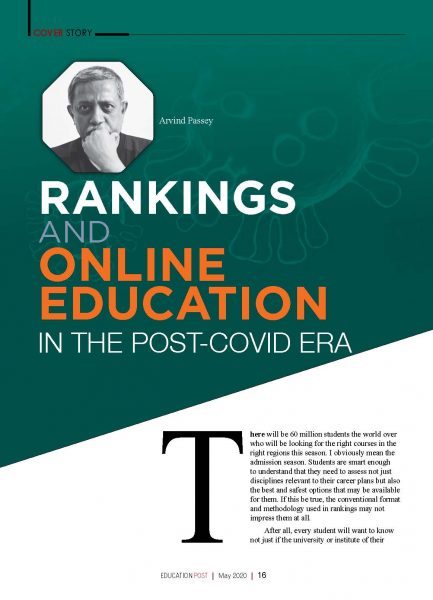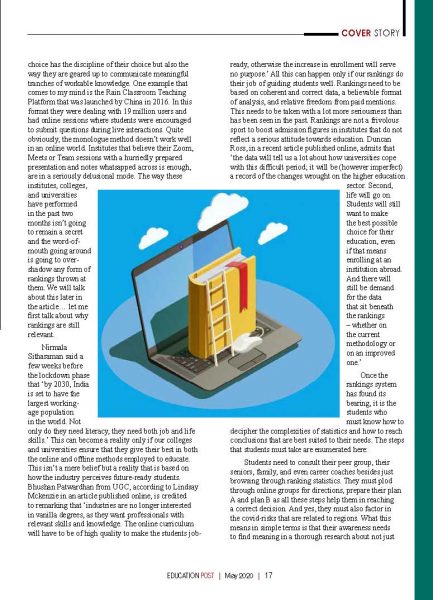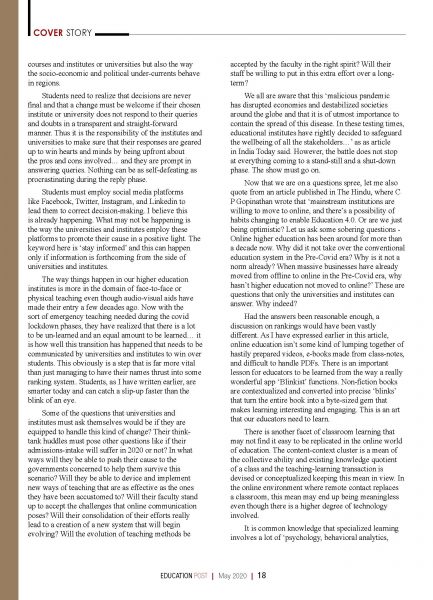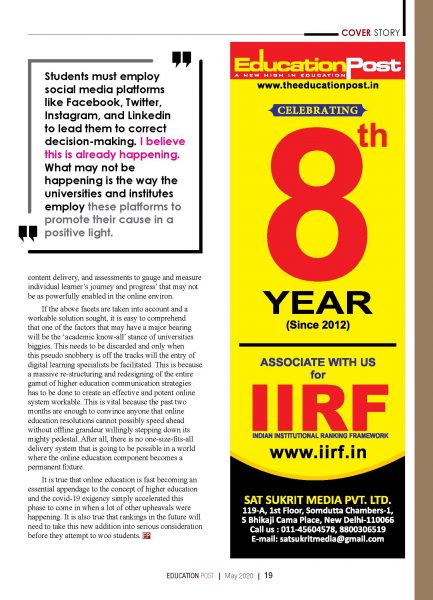There will be 60 million students the world over who will be looking for the right courses in the right regions this season. I obviously mean the admission season. Students are smart enough to understand that they need to assess not just disciplines relevant to their career plans but also the best and safest options that may be available for them. If this be true, the conventional format and methodology used in rankings may not impress them at all.
After all, every student will want to know not just if the university or institute of their choice has the discipline of their choice but also the way they are geared up to communicate meaningful tranches of workable knowledge. One example that comes to my mind is the Rain Classroom Teaching Platform that was launched by China in 2016. In this format they were dealing with 19 million users and had online sessions where students were encouraged to submit questions during live interactions. Quite obviously, the monologue method doesn’t work well in an online world. Institutes that believe their Zoom, Meets or Team sessions with a hurriedly prepared presentation and notes whatsapped across is enough, are in a seriously delusional mode. The way these institutes, colleges, and universities have performed in the past two months isn’t going to remain a secret and the word-of-mouth going around is going to over-shadow any form of rankings thrown at them. We will talk about this later in the article… let me first talk about why rankings are still relevant.
Nirmala Sitharaman said a few weeks before the lockdown phase that ‘by 2030, India is set to have the largest working-age population in the world. Not only do they need literacy, they need both job and life skills.’ This can become a reality only if our colleges and universities ensure that they give their best in both the online and offline methods employed to educate. This isn’t a mere belief but a reality that is based on how the industry perceives future-ready students. Bhushan Patwardhan from UGC, according to Lindsay Mckenzie in an article published online, is credited to remarking that ‘industries are no longer interested in vanilla degrees, as they want professionals with relevant skills and knowledge. The online curriculum will have to be of high quality to make the students job-ready, otherwise the increase in enrollment will serve no purpose.’ All this can happen only if our rankings do their job of guiding students well. Rankings need to be based on coherent and correct data, a believable format of analysis, and relative freedom from paid mentions. This needs to be taken with a lot more seriousness than has been seen in the past. Rankings are not a frivolous sport to boost admission figures in institutes that do not reflect a serious attitude towards education. Duncan Ross, in a recent article published online, admits that ‘the data will tell us a lot about how universities cope with this difficult period; it will be (however imperfect) a record of the changes wrought on the higher education sector. Second, life will go on. Students will still want to make the best possible choice for their education, even if that means enrolling at an institution abroad. And there will still be demand for the data that sit beneath the rankings – whether on the current methodology or on an improved one.’
Once the rankings system has found its bearing, it is the students who must know how to decipher the complexities of statistics and how to reach conclusions that are best suited to their needs. The steps that students must take are enumerated here:
- Students need to consult their peer group, their seniors, family, and even career coaches besides just browsing through ranking statistics. They must plod through online groups for directions, prepare their plan A and plan B as all these steps help them in reaching a correct decision. And yes, they must also factor in the covid-risks that are related to regions. What this means in simple terms is that their awareness needs to find meaning in a thorough research about not just courses and institutes or universities but also the way the socio-economic and political under-currents behave in regions.
- Students need to realize that decisions are never final and that a change must be welcome if their chosen institute or university does not respond to their queries and doubts in a transparent and straight-forward manner. Thus it is the responsibility of the institutes and universities to make sure that their responses are geared up to win hearts and minds by being upfront about the pros and cons involved… and they are prompt in answering queries. Nothing can be as self-defeating as procrastinating during the reply phase.
- Students must employ social media platforms like Facebook, Twitter, Instagram, and Linkedin to lead them to correct decision-making. I believe this is already happening. What may not be happening is the way the universities and institutes employ these platforms to promote their cause in a positive light. The keyword here is ‘stay informed’ and this can happen only if information is forthcoming from the side of universities and institutes.
The way things happen in our higher education institutes is more in the domain of face-to-face or physical teaching even though audio-visual aids have made their entry a few decades ago. Now with the sort of emergency teaching needed during the covid lockdown phases, they have realized that there is a lot to be un-learned and an equal amount to be learned… it is how well this transition has happened that needs to be communicated by universities and institutes to win over students. This obviously is a step that is far more vital than just managing to have their names thrust into some ranking system. Students, as I have written earlier, are smarter today and can catch a slip-up faster than the blink of an eye.
Some of the questions that universities and institutes must ask themselves would be if they are equipped to handle this kind of change? Their think-tank huddles must pose other questions like if their admissions-intake will suffer in 2020 or not? In what ways will they be able to push their cause to the governments concerned to help them survive this scenario? Will they be able to device and implement new ways of teaching that are as effective as the ones they have been accustomed to? Will their faculty stand up to accept the challenges that online communication poses? Will their consolidation of their efforts really lead to a creation of a new system that will begin evolving? Will the evolution of teaching methods be accepted by the faculty in the right spirit? Will their staff be willing to put in this extra effort over a long-term?
We all are aware that this ‘malicious pandemic has disrupted economies and destabilized societies around the globe and that it is of utmost importance to contain the spread of this disease. In these testing times, educational institutes have rightly decided to safeguard the wellbeing of all the stakeholders…’ as as article in India Today said. However, the battle does not stop at everything coming to a stand-still and a shut-down phase. The show must go on.
Now that we are on a questions spree, let me also quote from an article published in The Hindu, where C P Gopinathan wrote that ‘mainstream institutions are willing to move to online, and there’s a possibility of habits changing to enable Education 4.0. Or are we just being optimistic? Let us ask some sobering questions – Online higher education has been around for more than a decade now. Why did it not take over the conventional education system in the Pre-Covid era? Why is it not a norm already? When massive businesses have already moved from offline to online in the Pre-Covid era, why hasn’t higher education not moved to online?’ These are questions that only the universities and institutes can answer. Why indeed?
Had the answers been reasonable enough, a discussion on rankings would have been vastly different. As I have expressed earlier in this article, online education isn’t some kind of lumping together of hastily prepared videos, e-books made from class-notes, and difficult to handle PDFs. There is an important lesson for educators to be learned from the way a really wonderful app ‘Blinkist’ functions. Non-fiction books are contextualized and converted into precise ‘blinks’ that turn the entire book into a byte-sized gem that makes learning interesting and engaging. This is an art that our educators need to learn.
There is another facet of classroom learning that may not find it easy to be replicated in the online world of education. The content-context cluster is a mean of the collective ability and existing knowledge quotient of a class and the teaching-learning transaction is devised or conceptualized keeping this mean in view. In the online environment where remote contact replaces a classroom, this mean may end up being meaningless even though there is a higher degree of technology involved.
It is common knowledge that specialized learning involves a lot of ‘psychology, behavioral analytics, content delivery, and assessments to gauge and measure individual learner’s journey and progress’ that may not be as powerfully enabled in the online environ.
If the above facets are taken into account and a workable solution sought, it is easy to comprehend that one of the factors that may have a major bearing will be the ‘academic know-all’ stance of universities biggies. This needs to be discarded and only when this pseudo snobbery is off the tracks will the entry of digital learning specialists be facilitated. This is because a massive re-structuring and redesigning of the entire gamut of higher education communication strategies has to be done to create an effective and potent online system workable. This is vital because the past two months are enough to convince anyone that online education resolutions cannot possibly speed ahead without offline grandeur willingly stepping down its mighty pedestal. After all, there is no one-size-fits-all delivery system that is going to be possible in a world where the online education component becomes a permanent fixture.
It is true that online education is fast becoming an essential appendage to the concept of higher education and the covid-19 exigency simply accelerated this phase to come in when a lot of other upheavals were happening. It is also true that rankings in the future will need to take this new addition into serious consideration before they attempt to woo students. As for the meantime, it’s advisable to know how to select the right online learning platform to get the most benefits out of this new age of online education.
.
.
Article first published in Education Post as the cover story for the May 2020 issue:




.
.
.
Arvind Passey
07 June 2020








